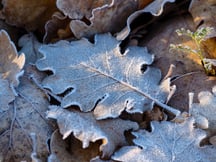 As summer gives way to autumn, you may notice a little nip in the air (depending on where you are). Leaves changing color, the start of football season and pumpkin-flavored everything are sure signs of the change in the season. While enjoying these, it’s also a good time to consider the challenges that changing seasons can cause for outdoor dust collector operations.
As summer gives way to autumn, you may notice a little nip in the air (depending on where you are). Leaves changing color, the start of football season and pumpkin-flavored everything are sure signs of the change in the season. While enjoying these, it’s also a good time to consider the challenges that changing seasons can cause for outdoor dust collector operations.
Below are a few examples of seasonal conditions that affect dust collection systems and how you might deal with them.
Moisture
First, and foremost, moisture can affect a dust collector in two primary ways.
Internal Condensation
For non-insulated dust collectors, cooler weather will cause more heat loss through the collector walls. This may lead to dew point excursions and condensation of moisture from the inlet air onto the dust collector walls and other internal components, including the filter bags. Free moisture inside the dust collector will mix with the collected dust and create a wet or muddy cake on the filter bags. This can cause operation at higher differential pressures and contribute to loss of conveying air throughout the system.
Insulating the collector walls, and in some cases, installation of heating elements on the hopper and housing can help prevent this from happening.
Ice Crystals
For pulse-jet dust collectors, cold weather will reduce the temperature in the valves and associated tubing. If the temperature drops below the rated dew point of the compressed air, ice crystals can form in the valves and tubing that will prevent the pulse cleaning system from operating properly.
Installation of a good dryer on the compressed air system can reduce the dew point to a level below the lowest expected ambient temperatures and prevent formation of ice within the system.
In addition, heated thermostat-activated solenoid enclosures can be used to maintain a temperature above freezing to prevent the valves from sticking due to ice formation.
Fan Performance in Cold Air
Cold air is denser (heavier) and requires more force (horsepower) to move it. Most fans are designed for operating conditions that are at or above 70 degrees F. When you start up the fan in colder temperatures, it may draw more amperage than the motor starter can handle, causing the motor to trip out. This is often mistaken as a fan problem when it is more a weather-related system operation problem.
A solution is to damper the fan back significantly so it will only draw a smaller volume of air through the system, which reduces the horsepower requirement and, subsequently, the amperage draw on the motor. As the system comes up to temperature, the damper can be opened back up to the full design flow condition.
Heat Issues
On the flip side of colder temperatures are issues with heat. High outdoor temperatures can cause significant problems with control panels and electrical boxes during summer months. The interior of the boxes can heat up significantly and most internal electronics do not respond well to higher temperatures.
The best way to solve this is to locate these out of direct sunlight as much as possible. Another option is to install air-conditioning units on larger enclosures.
These are just a handful of effects that a change in seasons can have on your dust collection system. Your best bet is to consult with dust collection experts to design the right solution that takes these issues into consideration from the start. Sly has more than 143 years of experience and has dealt with just about any issue you may face. We know what questions to ask to avoid potential pitfalls so you save time and money. Request a quote or call us at 1-866-721-3545 for more information.
Tags: dust collection system




